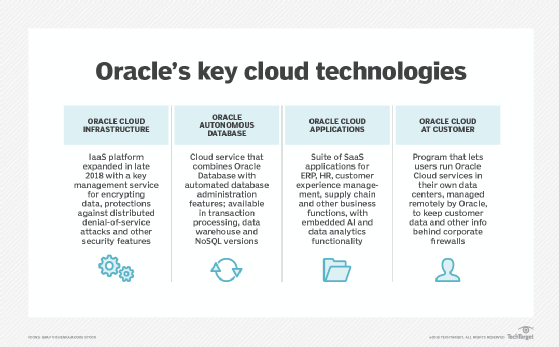
Fotolia
Get to know the core Oracle IaaS offerings
Oracle Cloud Infrastructure may not be for everyone, but it does have its appeal for certain workloads. Learn about the core IaaS tools that act as the service's foundation.
Even though Oracle still lags well behind market leader AWS in terms of tools and customers, it has made strides with its public cloud IaaS in recent years.
Oracle Cloud Infrastructure (OCI) -- the second Oracle IaaS incarnation -- was relatively late to the market. And while some questioned whether Oracle had missed the boat, it appears the offering has started to find an audience.
Because of its price-to-performance ratio, Oracle's cloud has gained traction with organizations that want to build custom, compute-intensive applications, according to Deepak Mohan, an IDC analyst. This includes industrial edge, high-performance computing and other cloud-native apps.
Oracle is still outside of the top five in IDC's ranking of IaaS market share -- though it's on that list for overall public cloud, if you include PaaS and SaaS, Mohan said. But Oracle has steadily added to its stable of IaaS and other cloud offerings as it seeks greater market share.
Oracle plans to expand to 36 regions by the end of 2020. And in addition to its flagship cloud-based database services, the Autonomous Database offerings, there are a range of Oracle IaaS and higher-level tools for security, management, analytics, app development and machine learning. Oracle has also partnered with Microsoft to support its workloads on Azure -- an indication that it might forgo the general IaaS market and continue to focus on specialization.

"In terms of their features and regions, they've definitely made solid advancements," Mohan said.
Any public cloud IaaS offering starts with core building blocks of compute, networking and storage. Check out this high-level overview of some of those notable services available on OCI, broken down by category.
Compute
Virtual Machines: Oracle breaks its VMs into two categories -- general purpose and Dense IO. While Oracle's IaaS doesn't have nearly the range of VM sizes or types as some of its competitors, it does sell more than two dozen VM sizes. Individual VMs max out at 24 cores, 320 GB of RAM and 1 petabyte (PB) of block storage.
Bare Metal: These instances are for applications that require isolation and/or high memory and bandwidth, with up to 64 cores, 768 GB of RAM and 1 PB of block storage. Oracle also sells bare metal and VM instances specifically designed for machine learning and high-performance computing, with up to 8 GPUs.
Container Engine for Kubernetes: This is a managed Kubernetes service that supports clusters on VMs and bare metal. It also integrates with the OCI load balancer and persistent volume services. Oracle also has a private, Docker-compatible image registry service for containers that run in the Kubernetes engine.
Storage
Block Volumes: These use NVMe solid-state drives (SSDs), with up to 32 TB per volume and 1 PB per instance, with a maximum 35,000 IOPS per volume. These volumes are used for NoSQL database applications or with Hadoop clusters, and they can be attached for read/write access or read-only. Other features of this Oracle IaaS offering include point-in-time backups, volume isolation and encryption at rest.
File Storage: This service can scale up to 8 exabytes, with automatic replications across availability domains. The service is built for file systems that share data across applications, including data migrated from on-premises data centers, as well as content management and web apps. Data is encrypted at rest and can be configured for encryption in transit.
Local NVMe SSD: These devices are locally installed on an instance. They scale up to 51.2 TB and offer latency as low as 10 microseconds. However, Oracle doesn't back the SSDs up, and the user is responsible for the durability of the data stored on the disks, typically through a RAID array.
Object Storage: This service is designed for unstructured data. Oracle encrypts the data at rest and replicates objects across domains for added durability. There is no cap on the amount of data that can be stored in a bucket, and there's also an archive storage tier that's one-tenth the price of the regular object storage cost.
Networking
DNS: This domain name system (DNS) service routes traffic across the internet for lower latency in reaching globally distributed end users, with query response times of under 30 milliseconds and records propagation times of under a minute. It has more than 600 collection points that transmit more than 240 billion data points daily, and OCI has ancillary DNS services to detect availability issues and set policies to automate query responses. DNS also has baked-in features to absorb global DDoS attacks, and the network itself is split in two to provide failover in the event of a catastrophic failure.
Fast Connect: This service forgoes the public internet for accelerated network connections to OCI. It provides up to 10 GBps speeds and eliminates data transfer costs between connected points.
VPN Connect: This is another option for those that want to connect OCI to an existing corporate network, with IPSec encryption for traffic over the public internet.
Load Balancer: This highly available service routes traffic automatically to handle increased load. It provides public IP addresses for incoming traffic, and users can add or remove application nodes via API or the OCI web console. It supports TCP, HTTP or HTTP/2 protocols and can manage Transport Layer Security handshakes.
Virtual Cloud Network (VCN): This is a customizable, low latency private network. IT teams can assign private IP addresses and add subnets, route tables and stateful firewalls. Resources can be grouped or isolated by putting multiple VCNs on one tenant.








